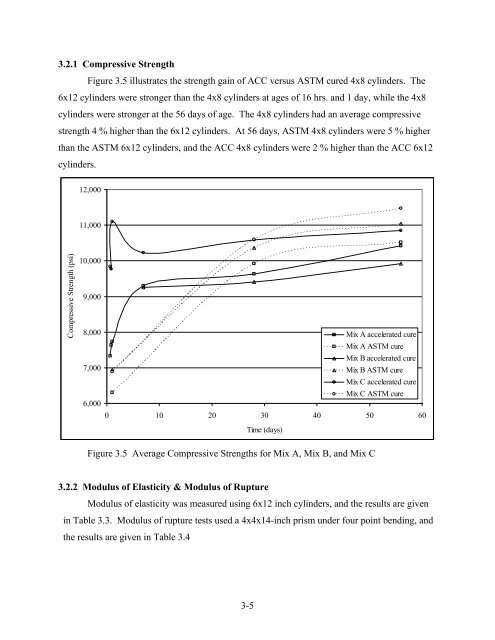Lightweight Concrete for High Strength - Expanded Shale & Clay
Lightweight Concrete for High Strength - Expanded Shale & Clay
Lightweight Concrete for High Strength - Expanded Shale & Clay
Create successful ePaper yourself
Turn your PDF publications into a flip-book with our unique Google optimized e-Paper software.
3.2.1 Compressive <strong>Strength</strong><br />
Figure 3.5 illustrates the strength gain of ACC versus ASTM cured 4x8 cylinders. The<br />
6x12 cylinders were stronger than the 4x8 cylinders at ages of 16 hrs. and 1 day, while the 4x8<br />
cylinders were stronger at the 56 days of age. The 4x8 cylinders had an average compressive<br />
strength 4 % higher than the 6x12 cylinders. At 56 days, ASTM 4x8 cylinders were 5 % higher<br />
than the ASTM 6x12 cylinders, and the ACC 4x8 cylinders were 2 % higher than the ACC 6x12<br />
cylinders.<br />
12,000<br />
11,000<br />
Compressive <strong>Strength</strong> (psi)<br />
10,000<br />
9,000<br />
8,000<br />
7,000<br />
6,000<br />
Mix A accelerated cure<br />
Mix A ASTM cure<br />
Mix B accelerated cure<br />
Mix B ASTM cure<br />
Mix C accelerated cure<br />
Mix C ASTM cure<br />
0 10 20 30 40 50 60<br />
Time (days)<br />
Figure 3.5 Average Compressive <strong>Strength</strong>s <strong>for</strong> Mix A, Mix B, and Mix C<br />
3.2.2 Modulus of Elasticity & Modulus of Rupture<br />
Modulus of elasticity was measured using 6x12 inch cylinders, and the results are given<br />
in Table 3.3. Modulus of rupture tests used a 4x4x14-inch prism under four point bending, and<br />
the results are given in Table 3.4<br />
3-5















